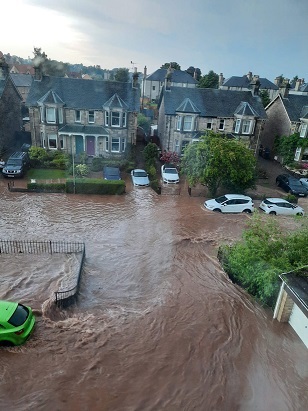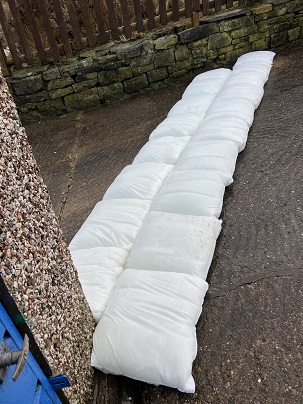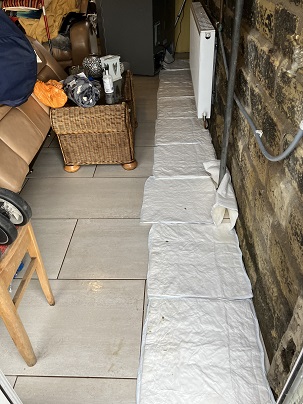 Flooding can happen anywhere, any time so people need to be prepared for it 24/7
Flooding can happen anywhere, any time so people need to be prepared for it 24/7
 These two rows of FloodSax alternative sandbags protected a property in West Yorkshire from being flooded, saving thousands of pounds in flood damage
These two rows of FloodSax alternative sandbags protected a property in West Yorkshire from being flooded, saving thousands of pounds in flood damage
 FloodSax can be used in the dry state inside to soak up leaks, floods and spills. These are confining water from a leaking roof to a small part of an extension, protecting the floor and furniture
FloodSax can be used in the dry state inside to soak up leaks, floods and spills. These are confining water from a leaking roof to a small part of an extension, protecting the floor and furniture
Carbon cost of repairing a flooded house is the same as 55 car trips from Land’s End to John O’Groats
The carbon cost of repairing a flooded house is enormous yet simple flood prevention measures can reduce or prevent it, according to insurance giant Aviva.
The company has revealed that the carbon cost of restoring a flooded home can be equivalent to six and a half return flights from London to New York or 55 car trips from Land’s End to John O’Groats.
Yet it can be so easily prevented in the first place using flood mitigation products to stop the water getting in and Aviva says the Government should do more to promote the need for all homeowners and businesses to be prepared to protect their property from flooding.
All is revealed in a report from Aviva called Building Future Communities which also calls for homes to be restored and built resiliently to withstand a future of extreme weather.
The company is calling on the Government to introduce stronger planning regulations with resilience factored into new properties while also encouraging people to make sure they are prepared with the right anti-flood products to protect their homes and businesses.
Aviva calculated the carbon cost of water from a river flooding a UK home - a three-bed, semi-detached, pre-1930s property. It compared the carbon emissions due to the flood event in two different scenarios - one when the property had no flood resilience measures and the second with simple measures installed such as flood doors, sealed brickwork and raised electrical points.
Without any property flood resilience measures in place, the carbon cost of restoring the flooded home was 13.9 tonnes of CO2e emissions. A home without resilience measures installed would likely be so badly damaged the homeowners would have to move out of their home for a considerable period.
Aviva said that putting in place simple property flood resilience measures is projected to lead to a 64% reduction in the carbon cost of a flood and decrease the depth of flood water to 20mm to 30mm. In turn, this means residents can remain in their homes which can help to lessen the emotional toll of a flood.
People can see a full range of flood protection products in a special directory on anti-flood charity the National Flood Forum website. The directory is called Blue Pages and click here to see it https://bluepages.org.uk/
One of the main products profiled there is FloodSax alternative sandbags https://www.floodsax.co.uk// which are used worldwide as highly effective instant flood protection barriers.
Managing director Richard Bailey said: “Being flooded is one of the worst things that can happen to anyone as water damages everything it touches. People are forced out for many months while the property dries out and is then repaired, not to mention having to sort out all the insurance and project manage the restoration. Flooding causes awful trauma which takes a terrible toll on people’s mental health.
“We always suspected that apart from the actual cost of repairing a flooded home – and the average is more than £30,000 – there was a heavy cost to the environment and Aviva has now revealed the true extent of the that.
“Although one in six homes in the UK are at risk of flooding – that’s 6 million properties – the sad truth is any home is in danger of being flooded from a torrential downpour, a burst water main or a major internal flooding leak.
“If people take the correct precautions then they can keep just about all floodwater out but many people forget that floods can happen inside and they have to be prepared for that too.”
To read about the ideal way to protect your home or business from flooding go to http://www.floodsax.co.uk/news/stopping-flooding-in-your-home-or-business-is-as-easy-as-1-2-3/
Unlike old-style sandbags, FloodSax work both inside and out.
FloodSax have earned a reputation worldwide as a robust alternative sandbag that can be made into a great temporary flood protection barrier to keep floodwater out of homes and businesses. To transform them into an instant ‘sandless’ sandbag simply immerse them in water and the gelling polymer inside the FloodSax absorbs the water and retains it. This also means FloodSax are largely biodegradable making them far more environmentally friendly than old-style, traditional sandbags.
But in their dry state they are very thin with a large surface area so are great at soaking up leaks, spills, drips and floods internally, especially in hard-to-reach places such as beneath boilers, underneath floorboards and below sinks.
Aviva chief executive Adam Winslow said: “With ambitious government plans to build new homes, it is crucial that any housing developments built on flood plains benefit from dual protection; flood defence systems to help prevent flooding in whole communities and resilience measures to minimise disruption.
“Unless more urgent action is taken to make our homes climate-ready, properties will be exposed to multiple threats from extreme weather, be it flooding, subsidence or over-heating. We simply cannot continue with the current status quo. Now is the time to act to make existing and future properties fit and prepared for the climate threats they will face in future.”
Aviva believes that recent floods have made people more aware about the dangers of flooding yet still far too few people are doing anything to protect their homes or businesses from floodwater.
The report states: “The extreme weather of 2022 appears to have made people more aware of the threats of climate change. Our research found that 45% of people think climate change will impact their home in the next year, compared to 38% in 2021. And although 80% of UK residents think homes should be resilient to extreme weather, the majority (67%) haven't installed resilience measures in their homes.”